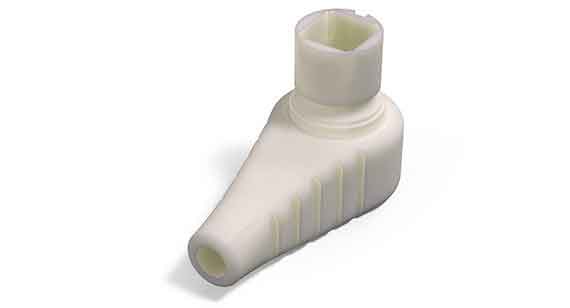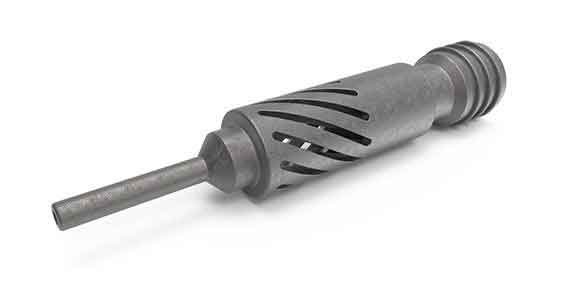Rapid Prototyping: There’s More Than One Way to Skin a CAD
Prototyping is the first step in any world-changing product. There are many software tools on the market to simulate part design and conduct an analysis of manufacturability, but having a physical model is a necessary step in any successful product development cycle.
Not only does it give users and customers a way to react to your potential design, but it also helps identify manufacturing issues early on in development—saving you from costly redesigns as you near production. Physical prototyping will help mitigate design risk and lead to a product that your customers will appreciate and find value in.

Concept Model
At the earliest stages of product development, when ideas are unrefined and vague, so are the prototypes. Even if the initial product ideas could use some additional thought, creating a physical model helps communicate an idea and get feedback from peers, customers, and any other stakeholders.
When fleshing out ideas and building concept models, manufacturing speed is extremely valuable since it will enable you to test and iterate more designs without sacrificing time to market. For this reason, 3D printing is often used to validate design early on. Whether produced in-house or outsourced to a 3D printing service provider, additive manufacturing can build concept models intended to spark conversation and gain design feedback.
Form and Fit Test
As the design moves along, the next step is often testing the assembly. This will usually coincide with discussions on which material will be used in for the part.
Given the prototyping process, the material used in production may not be available, but choosing a similar material can pay dividends later on. If you’re prototyping a molded part, 3D printing offers a variety of thermoplastic-like materials that, despite not being identical to their production counterparts, can be suitable at this stage in development.
We often encourage customers to design for moldability, even if it’s early in the process and the current iteration will be fabricated via 3D printing, machining, or something other than molding. This can save you from needing to make any substantial design changes once the time for production arrives.
Stereolithography (SL), a 3D printing process that cures thermoset resins, is often recommended for prototypes that are intended to evaluate form and fit. The technology produces parts with exceptional detail and quality surface finishes so they can easily mate with other components within an assembly and also have the feel of a final product. And, like we mentioned earlier, SL offers a number of thermoplastic-like materials, perfect for injection molding prototypes.

Don’t forget about CNC machining, though. You’ll find many product designers swear by machined prototypes if the part will be molded in production. A machined part will give a more accurate approximation of a molded part’s properties such as look, surface finish, and strength—perfect for understanding form and fit.
Functional Testing
Now that you’ve ironed out most of your part design, it’s time to make sure it functions as intended. Functional testing usually involves some level of user testing as well as assessing the mechanical properties of your design. And, don’t overlook chemical and electrical properties, both can have an impact on part performance. This is when material selection will start to come into focus.
If quantities are still in the handful of parts, 3D printing and machining can be viable. Powder bed fusion processes like selective laser sintering (SLS) and direct metal laser sintering (DMLS) are both capable of creating functional, durable parts.
At this point, some product developers will move straight to injection molding, since rapid injection molding process is a cost-effective solution for low volumes of parts. This is especially valuable when conducting market testing or pilot runs with select customers. Prototyping in production-grade materials can be an enlightening exercise since you can accurately examine your material choice and tolerances will remain consistent once you move to production.
The features in your design and materials will ultimately determine which manufacturing process will be most beneficial and economical for functional testing.
Regulatory Testing
Many products undergo regulatory testing prior to full-scale market launch to ensure performance and safety. Common approval processes include FDA, FCC, ISO, and UL. These tests will vary depending on the type of product and industry served, but some examples are electromagnetic interference properties, biocompatibility, or flammability.
For these tests, production parts are required. Rapid, on-demand injection molding can provide substantial value to companies wanting to get through regulatory approvals as fast as possible. With cost-effective aluminum tooling and production parts within days, regulatory testing can be completed in a fraction of the time compared to traditional molding.
Making the Most of a Prototype
The value of a physical prototype is hard to overstate. It’s the easiest and most intuitive way to gain feedback, improve upon your initial design, and mitigate design risk. And, with rapid manufacturing technologies like 3D printing and CNC machining, design iterations won’t cause major delays to your development process. Additionally, remaining mindful of the final manufacturing process and materials when prototyping, will help you get through any regulatory testing faster and ensure a smooth transition to your end goal, production parts and a market-ready product.